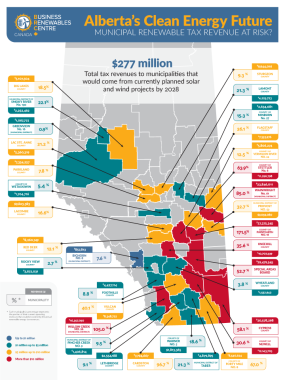Are growing municipal tax revenues from renewable energy at risk?

MEDIA RELEASE
CALGARY — The Alberta government could dramatically alter the economic fortunes of some southern Alberta communities with imminent announcements on clean energy rule changes.
A new analysis by the Business Renewables Centre-Canada (BRC-Canada) shows municipalities could bring in tax revenues of as much as $277 million annually by 2028 if all projects scheduled before the renewable energy pause proceed. The forecast revenues would flow to 33 municipalities, 19 more since BRC-Canada did its initial analysis last fall.
The government is about to lift the seven-month pause on approvals that it initiated in August 2023 and rules around development could follow closely. The details of those decisions will determine the scale of future development. Will the new rules block some projects from proceeding completely? Will they cast a chill over wind and solar project investments in the province as a whole? Municipal tax revenues would shrink as a result.
“Municipalities may never realize the full potential of what this renewable energy revenue boom could do for them — how it could change their lives and make their communities a more well-resourced, vibrant place to live — if the provincial government stifles clean energy development with unfair or unnecessary new regulations,” said Jorden Dye, BRC-Canada's director.
As it sits, 19 new municipalities will be added to the roster of municipalities making money from renewable energy. As well, many municipalities already bringing in revenues will see substantial increases in that revenue.
Eight municipalities would be making at least 50 per cent of their total current operating revenues.
This influx of sustained tax revenue represents a new kind of independence for these communities.
These revenues provide real opportunities for rural Albertans to make their dream projects happen. Hanna could build its Harvest Sky Agricultural Centre or develop its historic Railway Roundhouse as the modern community activity hub it’s always dreamed about. Or maybe the Special Areas Board could offset the costs of the large-scale irrigation project it has been striving towards for decades now. The County of Forty Mile could quickly finish its high-speed, open access broadband network and the County of Paintearth wouldn’t have to think twice about completing the Castor splash park or the inclusive playground at Coronation School.
While these projects are advancing under the capable hands of residents right now, it is possible to imagine that with additional, substantial new revenues they would proceed more quickly. Communities might decide not to wait for provincial government decisions on funding or grants. Aside from the quality-of-life improvements each of these projects will bring to the people living there, many of these projects have their own projections for additional spin-off economic benefits.
It is not for us to say what the money could best be used for. Residents know best. But we can say that residents will be empowered to dream bigger and watch their dreams come to fruition in a much shorter time than before.
There’s a big “if” looming over this bright future, though. The Alberta government could change the trajectory of the projected growth. “The specifics of these decisions will be the difference between gigawatts and megawatts of projects being built in Alberta,” Dye said.
Already, Alberta has lost its favoured status and energy developers are eyeing other jurisdictions, including Saskatchewan, Ontario, Quebec, Nova Scotia, and New Brunswick, according to a survey prepared for the Alberta Utilities Commission inquiry.
“Alberta doesn't have to give up first place,” said Dye. “But if they’re not careful with the changes they make, that’s what's at stake.”
Methods
This analysis looked only at projects in the pre-regulatory and regulatory approval phases. It does not include revenue that will come from projects currently under construction, as those amounts are secure. More details are available upon request.
Quick facts
Between January 2019 and December 31, 2023, 3.26 gigawatts (GW) of renewable energy have been purchased through corporate power purchase agreements, enabling a total of 4.1 GW of project capacity. This equates to 12,400 gigawatt-hours per year of energy provided, leading to the creation of:
- 6,214 jobs,
- $6.3 billion in capital investment, and
- production of enough energy to power 1.7 million homes.
Background
The Business Renewables Centre-Canada (BRC-Canada) is an initiative of the Pembina Institute. BRC-Canada exists to enable businesses and institutions to access renewable energy for their emissions reduction needs across Canada. This means working closely with buyers and developers of renewables and assisting them in shortening their learning curves as they figure out the best path to power purchase agreements. Our growing organization currently has about 60 participants from across all sectors of the Canadian economy.
-30-
Contact
Hanneke Brooymans (English)
Senior Communications Lead, Business Renewables Centre-Canada
587-336-4396
Background
Infographic: Alberta’s Clean Energy Future: Municipal Renewable Tax Revenue at Risk?
Blog: (Agrivoltaics) Solar farms and sheep show the makings of a clean energy classic duo
Blog: (Reclamation) A circular economy for rectangular solar panels
Blog: Renewable energy’s role in a reliable power system
